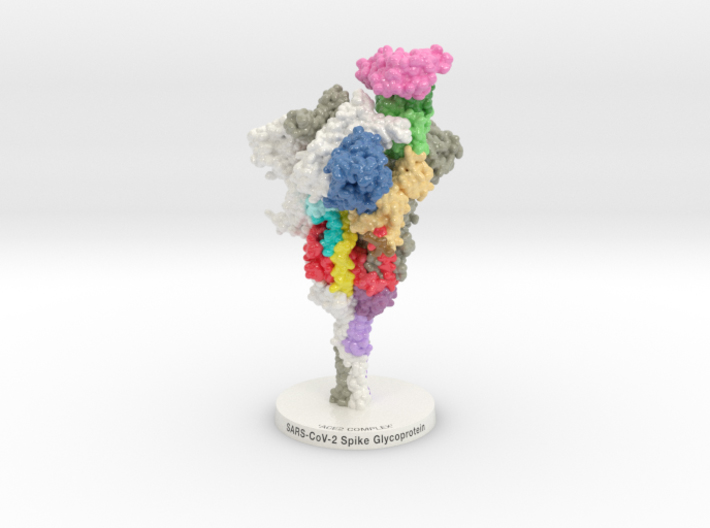
The outbreak of a novel coronavirus (SARS-CoV-2) represents a pandemic threat that has been declared a public health emergency of international concern. The CoV Spike Glycoprotein is a key target for vaccines, therapeutic antibodies, and diagnostics. The 3D printed structure of SARS-CoV-2 Spike Glycoprotein ACE2 Complex 6VXX-6M17 is designed to enable the rapid development and evaluation of medical countermeasures to address the ongoing public health crisis.
Biologic Model of SARS-CoV-2 Spike Glycoprotein 3D printed and colored-coded to denote functional domains (NTD blue, RBD green, SD1, light tan, SD2 red-orange-yellow, FP cyan, RRAR brown, ACE2 Receptor pink). SCIENCE recently published the work of Daniel Wrapp crystalizing the current generation of the SARS-CoV-2 Spike Glycoprotein, 2019-nCoV-2. Following the illustrations and supplemental materials describing each domain by amino acid sequence, a series of 3D models were generated for interactive exploration and 3D printing.
SARS-CoV-2 Spike Glycoprotein ACE2 Complex 6VXX-6M17

The membrane-bound configuration of SARS-CoV-2 Spike Glycoprotein (PDB ID: 6VXX, 6M17 seen below) is a trimer complex. At the top of each monomer is a receptor-binding domain (RBD green) that binds angiotensin-converting enzyme 2 (ACE2 pink) with a higher affinity than it does severe acute respiratory syndrome SARS-Coronavirus ‘Classic’ (2002). This in part is due to the unique modifications in the RBD that replace binding motifs with residues from a Pangolin virus (Dark green). Additionally, several published SARS-CoV S RBD-specific monoclonal antibodies were tested and found that they do not have appreciable binding to SARS-CoV-2, suggesting that antibody cross-reactivity may be limited, in part due to changes to these residues (Dark Green). The structure of SARS-CoV-2 should enable the rapid development and evaluation of medical countermeasures to address the ongoing public health crisis.
“The novel coronavirus 2019-nCoV has recently emerged as a human pathogen in the city of Wuhan in China’s Hubei province, causing fever, severe respiratory illness, and pneumonia—a disease recently named COVID-19 (1, 2). The emerging pathogen was rapidly characterized as a new member of the betacoronavirus genus, closely related to several bat coronaviruses and to severe acute respiratory syndrome coronavirus (SARS-CoV) (3, 4). Compared with SARS-CoV, 2019-nCoV appears to be more readily transmitted from human to human, spreading to multiple continents and leading to the WHO’s declaration of a Public Health Emergency of International Concern (PHEIC) on 30 January 2020 (1, 5, 6).”
Biologic Explorer: 6VXX-6M17
To better understand the bonds shared between the RBD domain of the Spike Glycoprotein and the ACE2 receptor, protein dataset 6M17 has been colorized to match our 3d printed model. Explore RBD Motif and the binding residues of the ACE2 below after “Initializing” the dataset.
Http iframes are not shown in https pages in many major browsers. Please read this post for details.Learn more about the SARS-CoV-2 Spike Glycoprotein: Learn More

